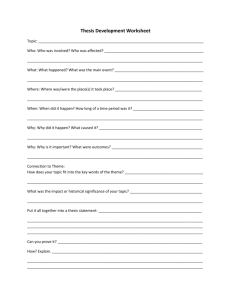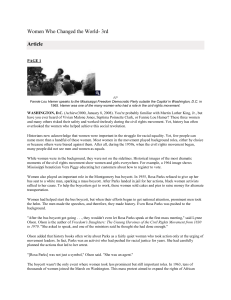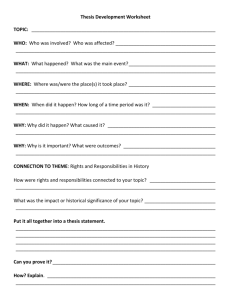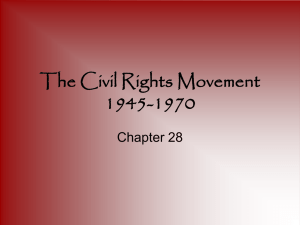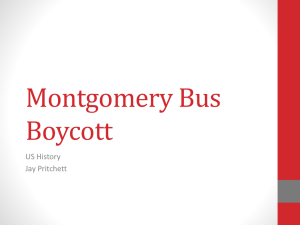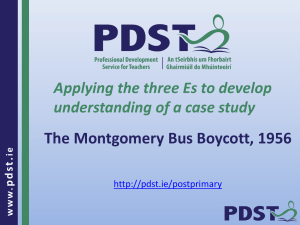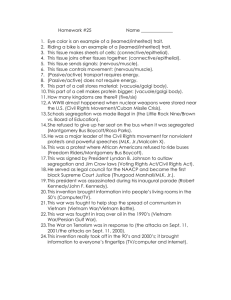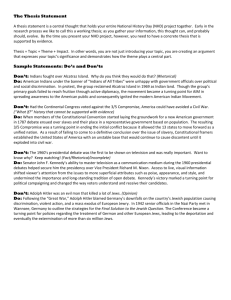Grade 6 Quarter 4 Freedom Walkers Writing Portfolio
advertisement
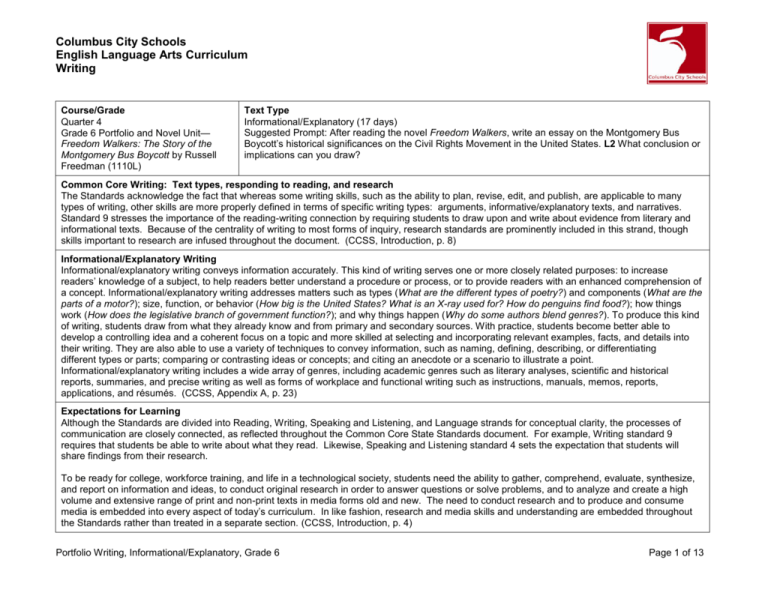
Columbus City Schools English Language Arts Curriculum Writing Course/Grade Quarter 4 Grade 6 Portfolio and Novel Unit— Freedom Walkers: The Story of the Montgomery Bus Boycott by Russell Freedman (1110L) Text Type Informational/Explanatory (17 days) Suggested Prompt: After reading the novel Freedom Walkers, write an essay on the Montgomery Bus Boycott‘s historical significances on the Civil Rights Movement in the United States. L2 What conclusion or implications can you draw? Common Core Writing: Text types, responding to reading, and research The Standards acknowledge the fact that whereas some writing skills, such as the ability to plan, revise, edit, and publish, are applicable to many types of writing, other skills are more properly defined in terms of specific writing types: arguments, informative/explanatory texts, and narratives. Standard 9 stresses the importance of the reading-writing connection by requiring students to draw upon and write about evidence from literary and informational texts. Because of the centrality of writing to most forms of inquiry, research standards are prominently included in this strand, though skills important to research are infused throughout the document. (CCSS, Introduction, p. 8) Informational/Explanatory Writing Informational/explanatory writing conveys information accurately. This kind of writing serves one or more closely related purposes: to increase readers‘ knowledge of a subject, to help readers better understand a procedure or process, or to provide readers with an enhanced comprehension of a concept. Informational/explanatory writing addresses matters such as types (What are the different types of poetry?) and components (What are the parts of a motor?); size, function, or behavior (How big is the United States? What is an X-ray used for? How do penguins find food?); how things work (How does the legislative branch of government function?); and why things happen (Why do some authors blend genres?). To produce this kind of writing, students draw from what they already know and from primary and secondary sources. With practice, students become better able to develop a controlling idea and a coherent focus on a topic and more skilled at selecting and incorporating relevant examples, facts, and details into their writing. They are also able to use a variety of techniques to convey information, such as naming, defining, describing, or differentiating different types or parts; comparing or contrasting ideas or concepts; and citing an anecdote or a scenario to illustrate a point. Informational/explanatory writing includes a wide array of genres, including academic genres such as literary analyses, scientific and historical reports, summaries, and precise writing as well as forms of workplace and functional writing such as instructions, manuals, memos, reports, applications, and résumés. (CCSS, Appendix A, p. 23) Expectations for Learning Although the Standards are divided into Reading, Writing, Speaking and Listening, and Language strands for conceptual clarity, the processes of communication are closely connected, as reflected throughout the Common Core State Standards document. For example, Writing standard 9 requires that students be able to write about what they read. Likewise, Speaking and Listening standard 4 sets the expectation that students will share findings from their research. To be ready for college, workforce training, and life in a technological society, students need the ability to gather, comprehend, evaluate, synthesize, and report on information and ideas, to conduct original research in order to answer questions or solve problems, and to analyze and create a high volume and extensive range of print and non-print texts in media forms old and new. The need to conduct research and to produce and consume media is embedded into every aspect of today‘s curriculum. In like fashion, research and media skills and understanding are embedded throughout the Standards rather than treated in a separate section. (CCSS, Introduction, p. 4) Portfolio Writing, Informational/Explanatory, Grade 6 Page 1 of 13 Columbus City Schools English Language Arts Curriculum Writing Strands/Topics Standard Statements Reading Informational Text: Key Ideas and Details RI.6.1 Cite textual evidence to support analysis of what the text says explicitly as well as inferences drawn from the text. RI.6.2 Determine a central idea of a text and how it is conveyed through particular details; provide a summary of the text distinct from personal opinions or judgments. RI.6.3 Analyze in detail how a key individual, event, or idea is introduced, illustrated, and elaborated in a text (e.g., through examples or anecdotes). Reading Informational Text: Craft and Structure RI.6.4 Determine the meaning of words and phrases as they are used in a text, including figurative, connotative, and technical meanings. RI.6.5 Analyze how a particular sentence, paragraph, chapter, or section fits into the overall structure of a text and contributes to the development of the ideas. RI.6.6 Determine an author‘s point of view or purpose in a text and explain how it is conveyed in the text. Reading Informational Text: Integration of Knowledge and Ideas RI.6.7 Integrate information presented in different media or formats (e.g., visually, quantitatively) as well as in words to develop a coherent understanding of a topic or issue. RI.6.8 Trace and evaluate the argument and specific claims in a text, distinguishing claims that are supported by reasons and evidence from claims that are not. RI.6.9 Compare and contrast one author‘s presentation of events with that of another (e.g., a memoir written by and a biography on the same person). Writing: Text Types and Purposes W.6.2 Write informative/explanatory texts to examine a topic and convey ideas, concepts, and information through the selection, organization, and analysis of relevant content. a. Introduce a topic; organize ideas, concepts, and information, using strategies such as definition, classification, comparison/contrast, and cause/effect; include formatting (e.g., headings), graphics (e.g., charts, tables), and multimedia when useful to aiding comprehension. b. Develop the topic with relevant facts, definitions, concrete details, quotations, or other information and examples. c. Use appropriate transitions to clarify the relationships among ideas and concepts. d. Use precise language and domain-specific vocabulary to inform about or explain the topic. e. Establish and maintain a formal style. f. Provide a concluding statement or section that follows from the information or explanation presented. Writing: Production and Distribution of Writing W.6.4 Produce clear and coherent writing in which the development, organization, and style are appropriate to task, purpose, and audience. W.6.5 With some guidance and support from peers and adults, develop and strengthen writing as needed by planning, revising, editing, rewriting, or trying a new approach. Writing: Research to Build and Present Knowledge W.6.8 Gather relevant information from multiple print and digital sources; assess the credibility of each source; and quote or paraphrase the data Portfolio Writing, Informational/Explanatory, Grade 6 Page 2 of 13 Columbus City Schools English Language Arts Curriculum Writing and conclusions of others while avoiding plagiarism and providing basic bibliographic information for sources. W.6.9 Draw evidence from literary or informational texts to support analysis, reflection, and research. a. Apply grade 6 Reading standards to literature (e.g., ―Compare and contrast texts in different forms or genres [e.g., stories and poems; historical novels and fantasy stories] in terms of their approaches to similar themes and topics‖). b. Apply grade 6 Reading standards to literary nonfiction (e.g., ―Trace and evaluate the argument and specific claims in a text, distinguishing claims that are supported by reasons and evidence from claims that are not‖). Speaking and Listening: Comprehension and Collaboration SL.6.1 Engage effectively in a range of collaborative discussions (one-on-one, in groups, and teacher-led) with diverse partners on grade 6 topics, texts, and issues, building on others‘ ideas and expressing their own clearly. a. Come to discussions prepared, having read or studied required material; explicitly draw on that preparation by referring to evidence on the topic, text, or issue to probe and reflect on ideas under discussion. b. Pose and respond to specific questions with elaboration and detail by making comments that contribute to the topic, text, or issue under discussion. c. Review the key ideas expressed and demonstrate understanding of multiple perspectives through reflection and paraphrasing. SL.6.2 Interpret information presented in diverse media and formats (e.g., visually, quantitatively, orally) and explain how it contributes to a topic, text, or issue under study. Language: Conventions of Standard English L.6.1 Demonstrate command of the conventions of standard English grammar and usage when writing or speaking. L.6.2 Demonstrate command of the conventions of Standard English capitalization, punctuation, and spelling when writing. a. Use punctuation (commas, parenthesis, dashes) to set off nonrestrictive/parenthetical elements. b. Spell correctly. Language: Vocabulary Acquisition and Use L.6.4 Determine or clarify the meaning of unknown and multiple-meaning words and phrases based on grade 6 reading and content, choosing flexibly from a range of strategies. a. Use context (e.g., the overall meaning of a sentence or paragraph; a word‘s position or function in a sentence) as a clue to the meaning of a word or phrase. L.6.5 Demonstrate understanding of figurative language, word relationships, and nuances in word meanings. a. Interpret figures of speech (e.g., personification) in context. b. Distinguish among the connotation (associations) of words with similar denotations (definitions) (e.g., stingy, scrimping, economical, unwasteful, thrifty). L.6.6 Acquire and use accurately grade-appropriate general academic and domain-specific words and phrases; gather vocabulary knowledge when considering a word or phrase important to comprehension or expression. Portfolio Writing, Informational/Explanatory, Grade 6 Page 3 of 13 Columbus City Schools English Language Arts Curriculum Writing Instructional Strategies Day One Novel Introduction: http://www.youtube.com/watch?v=pfEUstZa1hE Introduce the novel by showing the youtube video and the cover of the book Freedom Walkers: The Story of the Montgomery Bus Boycott by Russell Freedman. Discuss the terms ―boycott‖ and ―Jim Crow.‖ Discuss how Jim Crow laws and the setting of the novel are important to the key understanding of the novel. Develop the Essential Question for the novel unit: What is the overall significance of the Montgomery Alabama bus boycott? Depending on the students‘ needs, have students read aloud, read with a partner, read independently, or listen and read along with a skilled reader. Read Introduction, ―Why They Walked,‖ pp. 1-3. Discuss the use of the black and white photographs embedded in the chapter during or after reading. In closing, or as an exit ticket, have students generate three questions about the bus boycott or Jim Crow laws. Day Two Review the previous lesson and list the questions students generated. Post these questions on chart paper and refer to them throughout the novel unit. Read Chapter 1, ―Jo Ann Robinson,‖ pp. 4 – 13. Depending on the students‘ needs, have students read aloud, read with a partner, read independently, or listen and read along with a skilled reader. Discuss the use of the black and white photographs embedded in the chapter during or after reading. After reading the chapter, ask the students to explain why the author chose to begin the chapter with Jo Ann‘s anecdotal bus incident instead of the short biographical sketch that was read later in the chapter. How did this incident affect her later decisions in politics? There are many cause-effect relationships in this and every chapter of the novel. Discuss how the Supreme Court ruling on segregated schools affected Jo Ann‘s actions. Distribute Appendix Handout: Cause and Effect and have students find additional examples from the text. Distribute Appendix Handout: Timeline of the Montgomery Bus Boycott. Have the students enter key dates from the chapter. If possible, use different colors for individuals and organizations mentioned in the novel in order for the students to visualize the overlapping and cumulating events of the boycott. In closing, or as an exit ticket, have students generate more questions they may have or answers to previous questions. Day Three In preparation for reading this chapter, discuss or have the students do a quick write on the acronym NAACP. What do they know about it? What does it stand for? Where and when have they heard the term used? Read Chapter 2, ―Claudette Colvin,‖ pp. 14 – 22. Depending on the students‘ needs, have students read aloud, read with a partner, read independently, or listen and read along with a skilled reader. Discuss the use of the black and white photographs embedded in the chapter during or after reading. Portfolio Writing, Informational/Explanatory, Grade 6 Page 4 of 13 Columbus City Schools English Language Arts Curriculum Writing Discuss the reasons the author, Russell Freedman, included the incidents with Claudette Colvin and Mary Louise Smith. Why does he wait until this point in the novel to mention the NAACP? The author ends the chapter with the simple sentence, ―She was Rosa Parks.‖ Explain why the author does so. What effect on the reader does this sentence have? Have the students add the events from the chapter to Appendix Handout: Timeline of the Montgomery Bus Boycott. Day Four Many students have a basic knowledge of Rosa Parks, and the first three pages of Chapter 3: Rosa Parks help the reader gain more insightful knowledge about her involvement in civil rights prior to her historic bus incident. Have the students participate in a close reading of pages 23 – 25. Distribute Appendix Handout: Rosa Parks Close Reading. Students may annotate text as they read. Close Reading Directions (taken from achievethecore.org) 1. Introduce the passage and students read independently. Other than giving the brief definitions offered to words students would likely not be able to define from context (bolded in the text), avoid giving any background context or instructional guidance at the outset of the lesson while students are reading the text silently. This close reading approach forces students to rely exclusively on the text instead of getting background knowledge and levels the playing field for all students as they seek to comprehend the written words. 2. Read the passage out loud to the class as students follow along in the text. Asking students to listen to the passage exposes them to a second reading of the text before they begin their own close reading of the passage. Speaking clearly and carefully will allow students who are following along to improve in fluency while offering all students access to this complex text. Accurate and skillful modeling of the reading assists students who may not be fluent with accurate pronunciations and syntactic patterns of English. 3. Ask the class to answer a small set of text-dependent guided questions and perform targeted tasks about the passage, with answers in the form of notes, annotations to the text, or more formal responses as appropriate. As students move through these questions and reread the text, be sure to check for and reinforce their understanding of academic vocabulary in the corresponding text (which will be boldfaced the first time it appears in the text). At times, the questions may focus on academic vocabulary. Teacher or proficient student reads aloud as students follow along Rosa Parks had taken a special interest in Claudette Colvin‘s case. She knew Claudette. And she herself had suffered a similar experience twelve years earlier. In 1943, she had been thrown off a Montgomery bus for refusing to reenter through the back door after paying her fare. The bus driver had kept her money, ordered her to step outside, then driven away, leaving her standing on the sidewalk. (Q1) Portfolio Writing, Informational/Explanatory, Grade 6 Vocabulary fare: price charged for transportation Text-dependent question (Q1) What ideas might the author be suggesting rather than directly stating? Page 5 of 13 Columbus City Schools English Language Arts Curriculum Writing Parks worked as a seamstress in a downtown Montgomery department store ―where you had to be smiling and polite, no matter how rudely you were treated.‖ A soft-spoken woman of forty-two, she wore rimless spectacles and had her brown hair braided and rolled behind her head. She was admired in the black community as a dedicated volunteer who had served as secretary of the local NAACP since 1943 and was currently an adviser to the organization‘s Youth Council, which counted Claudette Colvin among its members. Parks had been training her high school charges to resist segregation wherever they could. Recently, she had sent them to the whites-only library to check out books.(Q2) Rosa had grown up on a humble Alabama farm not far from Montgomery. ―I was a field hand when I was quite young – not more than six or seven,‖ she recalled. ―I was given a flour sack like the other children and expected to collect one or two pounds of cotton.‖ Against great odds, Parks earned a high school diploma. At the time, Montgomery had no public high school for blacks. Rosa‘s family, ambitious for her advancement, arranged to send her to the laboratory school at Alabama State College, which trained black teachers. Rosa cleaned classrooms to help pay her way through school. After starting the eleventh grade, she had to drop out to care for her ailing grandmother, but she managed to return to school after she married. Rosa received her diploma when she was twenty years old, becoming one of a small number of black high school graduates in the city at that time. (Q3) ―But that still didn‘t help me much in getting a job,‖ she remembered. ―I had a high school diploma, but I could only get jobs that didn‘t need a diploma.‖ She worked in a shirt factory, as a helper in a hospital, and a number of other menial jobs before being hired by the Montgomery Fair department store, where she altered ready-to-wear clothing. (Q4) Park made extra money by taking in sewing on the side. She had done some work for Virginia Durr, wife of attorney Clifford Durr, and the two women became friends. The Durrs, a white couple, were known in Montgomery as outspoken equal rights activists. They thought so highly of Parks‘ civic activities that during the summer of 1955 they helped arrange a week‘s stay for Rosa at the Highlander Folk School in Monteagle, Tennessee, which held interracial workshops on how to promote integration. ―That was the first time in my life I had lived in an atmosphere of complete equality with members of the other race,‖ Parks said later. ―I did enjoy going up there.‖ (Q5) seamstress: woman whose occupation is sewing spectacles: glasses segregation: the practice of keeping people of different races apart (Q2) What can the reader infer about Rosa‘s motivation to volunteer for the NAACP? Cite evidence from the text to support your thinking. ambitious: desiring to achieve a goal (Q3) From this passage, identify three character traits that would describe Rosa Parks. Find examples from the text to support your reasoning for each trait. menial: lacking interest or dignity activists: people who support or oppose a controversial issue interracial: involving members of different races integration: the incorporating of people as equals into a society (Q4) How does the use of the word ―menial‖ impact the tone of the passage? Cite evidence from the text to support your answer. (Q5) Explain how Rosa‘s relationship with Virginia Durr produces a change in Rosa. Use examples and reasons from the text in your response. Day Five In a quick write, have the students list 3 – 4 new facts they learned about Rosa Parks from the previous lesson. Have students share their responses with a student partner. Portfolio Writing, Informational/Explanatory, Grade 6 Page 6 of 13 Columbus City Schools English Language Arts Curriculum Writing Review the previous day‘s close reading. Post the quote from the beginning of the chapter: ―The only tired I was, was tired of giving in.‖ Discuss why the author would select this quote from Rosa Parks. What is the meaning of the quote? Continue reading Chapter 3, ―Rosa Parks,‖ pp. 26 – 33. Depending on the students‘ needs, have students read aloud, read with a partner, read independently, or listen and read along with a skilled reader. (Stop at the end of the second new paragraph with the sentence “This was the beginning of the Montgomery Bus Boycott.” Discuss the use of the black and white photographs embedded in the chapter during or after reading. Refer to Question 4 from the close reading. What additional character traits could describe Rosa? As a formative assessment, ask students to differentiate between a physical description of a person (or character) and the character traits of a person. If time allows, use the following link to find a Rosa Parks Interview about the bus incident and the boycott from the website Academy of Achievement.org. Have students compare and contrast how Russell Freedman wrote about it and Mrs. Parks‘ own words. Day Six In a quick write, have students explain what a primary source is and then list 5 – 6 examples of primary source documents. Let students share their responses with an elbow partner. Review the previous lesson, and then, before reading, ask students to pay attention to the photographs and other primary sources in this particular section of the chapter. Finish reading Chapter 3, ―Rosa Parks,‖ pp. 33 – 35. Depending on the students‘ needs, have students read aloud, read with a partner, read independently, or listen and read along with a skilled reader. After reading, discuss how the author chose to quote part of the leaflet‘s message and include a photograph of the leaflet. Have students explain how the use of primary sources in the novel helps with the development of the novel‘s central idea. Have students update Appendix Handout: Timeline of the Montgomery Bus Boycott. Have the students analyze why the author had used several overlapping incidents to reach this point in the novel. How do these incidents contribute to the tone of the novel? As a formative assessment, have the students explain how the use of primary sources in the novel contributes to their understanding of the civil rights movement. Day Seven Up to this point in the novel, the author has chosen to include only incidents about women and young teens. Make sure students understand that all blacks were affected by the Jim Crow laws and clarify any misconceptions. Discuss why the author chose to begin the book from this point of view. Begin reading Chapter 4, ―Martin Luther King, Jr.,‖ pp. 36 – 42. Depending on the students‘ needs, have students read aloud, read with a partner, read independently, or listen and read along with a skilled reader. Discuss the use of the black and white photographs embedded in the chapter during or after reading. After reading, discuss how the author chooses to describe the first day of the boycott through Martin Luther King, Jr.‘s eyes. What impact does this have on the reader? Portfolio Writing, Informational/Explanatory, Grade 6 Page 7 of 13 Columbus City Schools English Language Arts Curriculum Writing As an exit ticket, ask the students to justify the author‘s reason to include the outcome of Rosa Parks‘ trial. How does it affect the boycott? Day Eight Review the previous day‘s lesson. Ask the students to do a quick write about how to solve a problem. Refer to this quick write when comparing Gandhi and Martin Luther King, Jr. Finish reading Chapter 4, ―Martin Luther King, Jr.,‖ pp. 42 – 47. Depending on the students‘ needs, have students read aloud, read with a partner, read independently, or listen and read along with a skilled reader. Discuss the use of the black and white photographs embedded in the chapter during or after reading. Discuss how the author develops for the reader Martin Luther King, Jr.‘s background and his election to preside over the Montgomery Improvement Association. Why did the author need to include the passage about new suits from Montgomery‘s city leaders? How does this passage support the author‘s point of view of Martin Luther King, Jr.? Follow the hyperlink Gandhi's Non-violent Salt March (1120L) to INFOhio and copy the article on Gandhi. (You must be logged onto a district computer to access the article on EBSCO Host.) Read the article to or with the class. Distribute Appendix Handout: Compare and Contrast, a Venn diagram to compare the two individuals. As an exit ticket, have the students summarize the information from the Venn diagram. If time allows, teachers may want to show a video clip of Coretta Scott King discussing the boycott and/or of Martin‘s decision to be president of the Montgomery Improvement Association. Day Nine In a quick write, have the students define the word ―hero.‖ Have students share their response with an elbow partner. Review the previous day‘s lesson. Ask students to think about what a hero is as they read the next chapter. Depending on the students‘ needs, have students begin reading aloud, read with a partner, read independently, or listen and read along with a skilled reader. Begin reading Chapter 5, ―Boycott Heroes,‖ pp. 49 – 54. On page 55, Martin Luther King, Jr. comes to a realization about segregation. Therefore, it is recommended to do a close reading when students reach page 54. Follow the directions from Day Four for Close Reading Instructions. Distribute Appendix Handout: Boycott Heroes Close Reading. Students can annotate text during the close reading. After the close reading, have students finish reading the rest of the chapter pp. 55 – 57. Teacher or proficient student reads aloud as students follow along p. 54 As the boycott continued, black leaders met with white officials in several attempts to reach a compromise agreement. The boycotters were not demanding an end to segregated seating on the buses. ―That‘s a matter for the legislature and the courts,‖ said King. ―We feel we have a plan within the (existing) law.‖ They had three demands: Portfolio Writing, Informational/Explanatory, Grade 6 Vocabulary Text-dependent question compromise: a way of reaching agreement in which each person or group gives up something that was wanted in order to end Page 8 of 13 Columbus City Schools English Language Arts Curriculum Writing 1) Courteous treatment on the buses. 2) Hiring of black drivers on routes serving black neighborhoods. 3) First-come, first-served seating by race, blacks from the back of the bus and whites from the front until all seats were taken. With that arrangement, blacks would no longer have to give up their seats for whites or stand over empty seats. (Q1) ―We will certainly be willing to guarantee courtesy,‖ said bus company attorney Jack Crenshaw, but he insisted that most drivers were, in fact, courteous. He rejected the demand for black drivers, arguing that blacks did not have the right to tell the company whom to hire. ―We have no intentions now or in the foreseeable future of hiring ‗niggras,‘‖ Crenshaw said. As for the main demand--bus seating--Crenshaw claimed that the boycotters‘ plan would be illegal under existing segregation laws. ―If it were legal I would be the first to go along with it, but it just isn‘t legal,‖ he said. (Q2) Fred Gray, attorney for the black delegation, disagreed. He pointed that a first-come, first-served arrangement was already in practice in some other southern cities. The boycotters‘ requests ―were not designed to integrate the buses,‖ Gray emphasized. ―Rather they were intended as very reasonable reforms. The city officials could have given in to us but they simply refused.‖ Attorney Crenshaw wouldn‘t budge. ―If we grant the Negroes these demands,‖ he finally said, ―they would go about boasting of a victory that they had won over the white people, and this we will not stand for.‖ ―I left the meeting despondent,‖ King wrote later. ―Feeling that our demands were moderate, I had assumed that they would be granted with little question. This experience, however, taught me a lesson…I saw that the underlying purpose of segregation was to oppress and exploit the segregated, not simply to keep them apart. Even when we asked for justice within the segregation laws, the ‗powers that be‘ were not willing to grant it. Justice and equality, I saw, would never come while segregation remained, because the basic purpose of segregation was to perpetuate injustice and inequality.‖ (Q3) an argument or dispute legislature: a body of elected people having the authority to make laws delegation: a group of persons chosen to represent others reform: an action, plan, rule, etc., that is meant to improve something despondent: extremely discouraged oppress: to treat a person or group of people in a cruel or unfair way exploit: to use someone or something in a way that helps you unfairly perpetuate: to cause something that should be stopped, such as a mistaken idea or a bad situation, to continue (Q1) Explain what the term ―firstcome, first-served‖ means as it is used in the passage. (Q2) What can the reader infer about Crenshaw‘s statement, ―If it were legal I would be the first to go along with it, but it just isn‘t legal.‖ Support your answer from evidence in the close reading. (Q3) Evaluate the claim made by Martin Luther King, Jr. about the segregation ―…that the underlying purpose of segregation was to oppress and exploit the segregated, not simply to keep them apart.” Find three examples from the close reading to support Martin‘s claim. . Refer to Question 3 and discuss why King‘s claim is important to understanding the underlying reasons for the fight for civil rights. As an exit ticket/formative assessment, have the students write a brief summary of Martin Luther King, Jr.‘s claim that the laws were created to oppress the African American citizens. Portfolio Writing, Informational/Explanatory, Grade 6 Page 9 of 13 Columbus City Schools English Language Arts Curriculum Writing Day Ten As a quick write, have the students discuss the meaning of bravery. Have them list three to five events in the novel where people had shown bravery. Have students share their responses with the class. Discuss the role of the white activists. Discuss why these individuals were considered brave to support the efforts of the boycotters. Depending on the students‘ needs, have students read aloud, read with a partner, read independently, or listen and read along with a skilled reader. Begin reading Chapter 6, ―Proud to be Arrested,‖ pp. 59 – 69. Discuss the title of the chapter ―Boycott Heroes.‖ Why did the author use that term to describe the ordinary people participating in the boycott? Discuss the connotation of the word ―heroes.‖ Explain the difference between connotation and denotation. As a resource, review the Vocabulary Workshop on Connotation and Denotation: pages 678 – 679 in Pearson‘s Prentice Hall: Literature, Language, and Literacy. Divide students into groups. Distribute Appendix Handout: Denotation and Connotation. Assign each group a chapter from Chapters 1 – 6 to find examples of positive and negative connotations. Have each group select one word from their chapter and create a poster for the word. Each poster should include the word, the literal meaning, and an explanation of the connotative meaning. Give students time to share their posters. Day Eleven Review timeline and key events of the novel. Depending on the students‘ needs, have the students read aloud, read with a partner, read independently, or listen and read along with a skilled reader. Finish reading Chapter 6, ―Proud to be Arrested,‖ pp. 69 – 73. Discuss the actions of the boycott leaders, turning themselves in to the police, and the boycott supporters. As a formative assessment, ask the students to write a quick summary explaining why the boycott leaders were proud that they were arrested. Writing Portfolio Chapters 6, 7, and 8 will focus more on the boycott than with the individuals who played key roles; therefore, this is an appropriate time to begin the writing portfolio which focuses on the significance of the boycott movement. After reading today‘s chapter, introduce and explain the writing prompt: ―After reading the novel Freedom Walkers, write an essay on the Montgomery Bus Boycott‘s historical significances on the Civil Rights Movement in the United States.‖ L2 What conclusion or implications can you draw? (Students who are proficient or above should include the L2: What conclusion or implications can you draw?) Explain that students will write an information essay using the writing process. Distribute Appendix Handout: Writing Tips for an Informational Essay and Appendix Handout: Writing Prompt Outline. Have students write their focus statements on their outline. Day Twelve Review the timeline and key events of the novel. In a quick write, have the students pick one event from the timeline and explain its significance to the boycott. Students can share their response with an elbow partner. Discuss the title of the chapter ―Walking to Victory‖ before beginning the reading assignment. Portfolio Writing, Informational/Explanatory, Grade 6 Page 10 of 13 Columbus City Schools English Language Arts Curriculum Writing Depending on the students‘ needs, have students read aloud, read with a partner, read independently, or listen and read along with a skilled reader. Read Chapter 7, ―Walking to Victory,‖ pp. 75 – 87. Writing Portfolio Review the writing prompt and the students‘ focus statements from the previous lesson. As a class, create a visual listing of the boycott‘s events that impacted the civil rights movement for the nation. Discuss which events had major impacts on the national movement. Have each student choose at least three events from the list to include in her/his essay and list the events in order of importance on the outline. Then, have students refer to the novel to find evidence they will use to support each event. Day Thirteen Review the boycott‘s success from the previous chapter. As a quick write or oral discussion, discuss Martin Luther King, Jr.‘s quote ―We shall not be satisfied until justice flows like waters and righteousness like a mighty stream” (p. 47). This quote also is written on the Civil Rights Memorial created by Maya Lin. Depending on the students‘ needs, have students read aloud, read with a partner, read independently, or listen and read along with a skilled reader. Read Chapter 8, ―The Children Coming On…,‖ pp. 89 – 99. Discuss how the chapter provides a resolution for the reader about both the bus boycott and fight for civil rights. As a closing activity for the novel, have the students choose one of the quotes from the chapter headings. Distribute Appendix Handout: Quotes of the Freedom Walkers. Students should explain what the quoted person meant by her/his words and then explain why the author chose that quote to highlight in the chapter heading. Have students use evidence from the text in their responses. Students can share their responses in a Gallery Walk. Put each quote on a piece of chart paper. Students can cut out their responses and attach them to the chart paper. As students conduct the gallery walk, they can make comments about the quotes on post-its. Leave the papers up so students can read them during the rest of the unit. Writing Portfolio Using Appendix Handout: Writing Prompt Outline, students should continue to find and list evidence from the novel to include in their essays. Day Fourteen Writing Portfolio Explain to the students that they will draft their essays today. Ask students to get out Appendix Handout: Writing Tips for an Informational Essay that they received on Day Eleven. Review thesis statements, introductory techniques, and effective conclusions. This handout summarizes strategies from the first three portfolio units. Model how to write introductory paragraphs with the thesis statement as the last sentence in the introduction. To tie in the previous day‘s lesson, students may want to start their essays with one of the quotes from the chapter headings or any prominent quote from the novel. Students will have today and tomorrow to compose their essays. Portfolio Writing, Informational/Explanatory, Grade 6 Page 11 of 13 Columbus City Schools English Language Arts Curriculum Writing Day Fifteen Writing Portfolio Review Appendix Handout: Writing Tips for an Informational Essay. Model ways for students to conclude their essays. Students should complete their essays. Day Sixteen Revise and edit essay. Model how to revise and edit an informational essay. Go over the use of quotation marks. Use The Write Source pages 598 and 600 as a resource. Use the revision and editing checklists on pages 402 and 404 of The Write Source as a resource. Take the time to check for one feature at a time. Once students have gone through the checklists, have them begin writing their final copy. Day Seventeen Have students complete the final draft of their essay. Have students ―publish‖ their papers in some way. Possibilities are, but are not limited to, oral presentations, small groups, bulletin board, PowerPoints, or posters. Instructional Resources Ohio Resource Center Lesson on Capturing the Moment http://www.ohiorc.org/for/ela/browse.aspx?txtSearchText=civil%20rights%20movement Coretta Scott King: Preparing to start a movement/ The Montgomery Bus Boycott http://www.youtube.com/watch?v=_6tgr7gOXiI Additional resources on civil rights movement can be found at http://historyexplorer.si.edu/home/ Use the search feature to find specifics. The National Civil Rights Museum www.civilrightsmuseum.org National Park Service: Martin Luther King, Jr. National Historic Site Rosa Parks video tour of Rosa Parks Library and Musuem Martin Luther King, Jr. I Have a Dream Speech (full speech) http://www.youtube.com/watch?v=smEqnnklfYs Montgomery Bus Boycott http://www.history.com/topics/black-history/martin-luther-king-jr/videos/montgomery-busboycott?m=528e394da93ae&s=undefined&f=1&free=false NAACP official site http://www.naacp.org/ Portfolio Writing, Informational/Explanatory, Grade 6 Page 12 of 13 Columbus City Schools English Language Arts Curriculum Writing Integration of Knowledge and Ideas (Strategies for Diverse Learners) Students with disabilities or English language learners may benefit from listening to the audio tape version of the book. iCivics https://www.icivics.org is an interactive social studies site that has teacher resources, lesson plans, and interactive games for students. Log onto iCivics, register for a free account and search for the ―The Road to Civil Rights‖ unit. Select the activities appropriate for your diverse learners. Scaling Back to Essentials: Scaffolding Summarization With Fishbone Mapping http://www.readwritethink.org/classroom-resources/lessonplans/scaling-back-essentials-scaffolding-277.html A Taste of Freedom: Ghandi and the Great Salt March by Elizabeth Cody Kimmel (2014) Professional Articles Closer Reading for Deeper Comprehension: Uncommon Sense About the Common Core http://www.ohiorc.org/adlit/InPerspective/Issue/2012-10/Article/feature.aspx How to select and conduct a close reading from readwritethink.org Close Reading Ohio Resource Center article in AdLIT In Perspective (February 2007) issue entitled Differentiating Instruction in Secondary Classrooms Standards-Based Instruction for Adolescents with Special Needs: Looking for Ways to Turn All Students into Engaged Readers and Capable Writers http://www.ohiorc.org/adlit/differentiated_instruction/fayne.aspx?id=special_needs Civil Rights Act of 1964 http://www.history.com/topics/black-history/civil-rights-act English Language Arts Connections Reading Incorporate Common Core Reading (Literary or Informational Texts) standards as students complete research to build and present knowledge. http://www.corestandards.org Portfolio Writing, Informational/Explanatory, Grade 6 Language Incorporate Common Core Language standards as students construct writing in terms of writing conventions, knowledge of language, and acquisition and use of vocabulary. http://www.corestandards.org Speaking and Listening Incorporate Common Core Speaking and Listening standards as students integrate and evaluate information presented in diverse media and formats. http://www.corestandards.org Page 13 of 13 Appendix Cause and Effect A cause makes something happen. An effect is the result of something— of an event or a decision or situation. Many times, as in the case of the Montgomery Bus Boycott, there are many causes for one event. Find three causes from the novel for the Montgomery Bus Boycott. Describe the incident and justify the reason for identifying it as a cause. Cause Cause Cause Justification Justification Justification Effect Montgomery Bus Boycott Freedom Walkers: The Story of the Montgomery Bus Boycott Timeline Fill the boxes below with the important event that occurred on the date listed in the box. Summer 1949 Christmas 1949 May 1954 October 1955 December 1 1955 December 5 1955 March 1956 June 1956 March 1955 January 1956 November 1956 Summer 1955 February 1956 December 1956 Rosa Parks Close Reading Rosa Parks had taken a special interest in Claudette Colvin‘s case. She knew Claudette. And she herself had suffered a similar experience twelve years earlier. In 1943, she had been thrown off a Montgomery bus for refusing to reenter through the back door after paying her fare. The bus driver had kept her money, ordered her to step outside, then driven away, leaving her standing on the sidewalk. (Q1) Parks worked as a seamstress in a downtown Montgomery department store ―where you had to be smiling and polite, no matter how rudely you were treated.‖ A soft-spoken woman of forty-two, she wore rimless spectacles and had her brown hair braided and rolled behind her head. She was admired in the black community as a dedicated volunteer who had served as secretary of the local NAACP since 1943 and was currently an adviser to the organization‘s Youth Council, which counted Claudette Colvin among its members. Parks had been training her high school charges to resist segregation wherever they could. Recently, she had sent them to the whites-only library to check out books. (Q2) Rosa had grown up on a humble Alabama farm not far from Montgomery. ―I was a field hand when I was quite young – not more than six or seven,‖ she recalled. ―I was given a flour sack like the other children and expected to collect one or two pounds of cotton.‖ Against great odds, Parks earned a high school diploma. At the time, Montgomery had no public high school for blacks. Rosa‘s family, ambitious for her advancement, arranged to send her to the laboratory school at Alabama State College, which trained black teachers. Rosa cleaned classrooms to help pay her way through school. After starting the eleventh grade, she had to drop out to care for her ailing grandmother, but she managed to return to school after she married. Rosa received her diploma when she was twenty years old, becoming one of a small number of black high school graduates in the city at that time. (Q3) ―But that still didn‘t help me much in getting a job,‖ she remembered. ―I had a high school diploma, but I could only get jobs that didn‘t need a diploma.‖ She worked in a shirt factory, as a helper in a hospital, and a number of other menial jobs before being hired by the Montgomery Fair department store, where she altered ready-to-wear clothing. (Q4) Parks made extra money by taking in sewing on the side. She had done some work for Virginia Durr, wife of attorney Clifford Durr, and the two women became friends. The Durrs, a white couple, were known in Montgomery as outspoken equal rights activists. They thought so highly of Parks‘ civic activities that during the summer of 1955 they helped arrange a week‘s stay for Rosa at the Highlander Folk School in Monteagle, Tennessee, which held interracial workshops on how to promote integration. ―That was the first time in my life I had lived in an atmosphere of complete equality with members of the other race,‖ Parks said later. ―I did enjoy going up there.‖ Compare and Contrast Fill out the Venn diagram by comparing and contrasting Martin Luther King, Jr. and Mahatma Gandhi. When finished, write a summary paragraph about the men using the information from the diagram. Mahatma Gandhi Martin Luther King, Jr. __________________________________________________________ __________________________________________________________ __________________________________________________________ __________________________________________________________ __________________________________________________________ __________________________________________________________ __________________________________________________________ Boycott Heroes Close Reading As the boycott continued, black leaders met with white officials in several attempts to reach a compromise agreement. The boycotters were not demanding an end to segregated seating on the buses. ―That‘s a matter for the legislature and the courts,‖ said King. ―We feel we have a plan within the (existing) law.‖ They had three demands: 1) Courteous treatment on the buses. 2) Hiring of black drivers on routes serving black neighborhoods. 3) First-come, first-served seating by race, blacks from the back of the bus and whites from the front until all seats were taken. With that arrangement, blacks would no longer have to give up their seats for whites or stand over empty seats. ―We will certainly be willing to guarantee courtesy,‖ said bus company attorney Jack Crenshaw, but he insisted that most drivers were, in fact, courteous. He rejected the demand for black drivers, arguing that blacks did not have the right to tell the company whom to hire. ―We have no intentions now or in the foreseeable future of hiring ‗niggras,‘‖ Crenshaw said. As for the main demand--bus seating-- Crenshaw claimed that the boycotters‘ plan would be illegal under existing segregation laws. ―If it were legal I would be the first to go along with it, but it just isn‘t legal,‖ he said. Fred Gray, attorney for the black delegation, disagreed. He pointed that a first-come, first-served arrangement was already in practice in some other southern cities. The boycotters‘ requests ―were not designed to integrate the buses,‖ Gray emphasized. ―Rather they were intended as very reasonable reforms. The city officials could have given in to us but they simply refused.‖ Attorney Crenshaw wouldn‘t budge. ―If we grant the Negroes these demands,‖ he finally said, ―they would go about boasting of a victory that they had won over the white people, and this we will not stand for.‖ ―I left the meeting despondent,‖ King wrote later. ―Feeling that our demands were moderate, I had assumed that they would be granted with little question. This experience, however, taught me a lesson…I saw that the underlying purpose of segregation was to oppress and exploit the segregated, not simply to keep them apart. Even when we asked for justice within the segregation laws, the ‗powers that be‘ were not willing to grant it. Justice and equality, I saw, would never come while segregation remained, because the basic purpose of segregation was to perpetuate injustice and inequality.‖ Connotation and Denotation Sometimes the words that people speak or write produce certain feelings when we hear or read them. These feelings can make us feel good, bad, or maybe just okay. This is called connotation and denotation. Denotation is a word‘s definition. Connotation is the feeling a word evokes. Word connotations can have a positive feeling, a negative feeling, or a neutral feeling. A reader should read the whole sentence to determine the overall feeling the word evokes. For instance, on pages 61 and 62 in Freedom Walkers, look at how the word radical is used. The city commissioners were convinced that most blacks wanted to ride the buses but were tricked and manipulated by the boycott leaders, “a group of Negro radicals,” the mayor called them. Webster‘s Dictionary defines radical as a person who favors rapid and sweeping changes. Synonyms for radical include: crazy, extremist, or revolutionary. Word radical revolutionary Denotation a person who favors rapid and sweeping changes a person who brings about a big change Connotation a person who takes extreme measures to make change occur a person who helps make important changes Positive/Negative/Neutral negative feeling positive feeling Now find examples of words used by the author or from quotes in the novel. Use dictionaries to find the denotation. Then give the connotative meaning as the word is used in the novel. Finally, decide if the word evokes a positive or negative feeling. Word & page # Denotation Connotation Positive/Negative/Neutral Writing Tips for an Informational Essay These tips are from the first three novel units. Students should continue to use these strategies in their writing. Thesis Statement A thesis statement clearly introduces the main idea of your essay. It is often called a focus statement. To secifically address the writing prompt, turn your prompt into a question and, then, restate and answer it. That will help you focus in on the main idea. Writing Prompt: After reading the novel Freedom Walkers, write an essay on the Montgomery Bus Boycott‘s historical significances on the Civil Rights Movement in the United States. L2 What conclusion or implications can you draw? Question: What were the Montgomery Bus Boycott’s historical significances on the Civil Rights Movement in the United States? The answer is your thesis statement. Introductory Paragraph The first paragraph should draw the reader further into the essay to find out more about your particular topic. The structure of this paragraph should include a ―hook,‖ several general sentences about the topic, and then the thesis statement about your topic. Below are several methods to ―hook‖ your reader. Practice beginning your essay with all four. You may want to ask several classmates which one really grabs their attention, but ultimately, you choose the one that will best help support your focus statement. A startling or thoughtful fact on the topic A quote from an expert on the topic An anecdote (short experience) about the topic A rhetorical question (a thoughtful question on the topic that gets the audience to think, not to respond aloud) Writing Tips for an Informational Essay, cont’d Body Paragraphs Use your Informational Essay Graphic Organizer Outline to help develop each of your body paragraphs. For an informational article, each body paragraph should have a strong topic sentence that is supported by details (facts, examples, quotes, etc.) from the text. Arrange the body paragraphs by order of importance (significance). Remember to use transitional words to make your essay flow. Conclusion The conclusion to an essay uses the basic structure of summarizing the essay and restating your general thesis statement. The restatement, however, is not a direct restatement of your focus statement. In other words, you are going to say the same thing, but in a different way. Revise After writing a first draft of an essay, think about how to improve the writing. Check over your writing for the Six Traits of Writing: Ideas, Organization, Voice, Word Choice, Sentence Fluency, and Conventions. Edit Check your writing for punctuation, capitalization, spelling, and grammar. Writing Prompt Outline Writing Prompt: After reading the novel Freedom Walkers, write an essay on the Montgomery Bus Boycott’s historical significances on the Civil Rights Movement in the United States. Writers always have a plan before they begin composing their essays. You have been reading Freedom Walkers: The Story of the Montgomery Bus Boycott. Now, starting with your thesis statement, fill in the information that you want to include in your paper.This plan will help guide your writing. Introductory paragraph with thesis statement Body paragraph one: first event with supporting details (facts, examples, quotes, etc.) Body paragraph two: second event with supporting details (facts, examples, quotes, etc.) Body paragraph three: third event with supporting details (facts, examples, quotes, etc.) Concluding paragraph: summary of essay with restatement of thesis Chapter Heading Quotes from Freedom Walkers: The Story of the Montgomery Bus Boycott Choose one chapter heading quote. Explain what the person meant by the words and why the author chose this quote to represent the chapter. Use evidence from the text to support your answer. Chapter One “Get up from there! Get up from there!” Chapter Two “It’s my constitutional right!” Chapter Three “The only tired I was, was tired of giving in.” Chapter Four “I don’t want anybody to call me a coward.” Chapter Five “My feets is tired, but my soul is rested.” Chapter Six “I say, let’s all go to jail.” Chapter Seven “We are glad to have you this morning.” Chapter Eight “The children coming on behind us ought to know the truth about this.” __________________________________________________________ __________________________________________________________ __________________________________________________________ __________________________________________________________ __________________________________________________________ __________________________________________________________ __________________________________________________________ __________________________________________________________ __________________________________________________________

